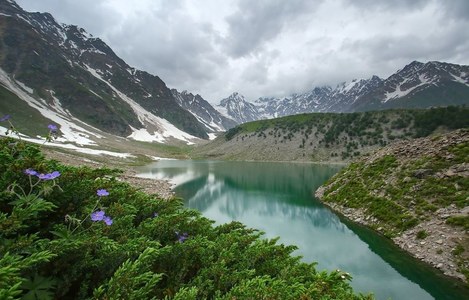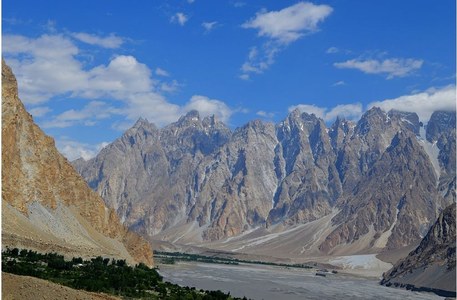The melting ice caps in the northern regions of Pakistan ring alarm bells as global warming intensifies and the locals stat panicking with impending environmental concern.
Late a month ago, inhabitants of the minuscule town of Hassanabad, in Hunza region, saw floodwaters rapidly ascending in the stream that runs close to their homes, conveying water from the transcending Shishper glacier. For generations, farmers in the Harchi Valley in Pakistan's highlands enjoyed a close relationship with the glacier that snakes between two mountain peaks. It watered their fields, orchards and grazing lands.
As ice melts, there is risk of large glacial lakes bursting through banks and creating deadly flash floods downstream. "The flows became so high that they eroded the land and reached 10 feet (three metres) from my family's home. We evacuated," said Ghulam Qadir, a resident of the village. The ensuing flood, carrying enormous boulders from the melting glacier, destroyed the cherry, apricot and walnut orchards many families depend on, and left homes splintered 16 families stranded in tents, and local irrigation and hydro-powered systems damaged.

The flood water broke all the retaining walls that were built last year in order to protect the village, Qadir told the Thomson Reuters Foundation by telephone.
“Now there is a ravine right next to our houses and we live in dread of another flood.”
The region is one of 24 valleys in northern Pakistan booked to get notice frameworks, somewhere in the range of 2018 and 2022, for cold lake upheaval floods utilizing $37 million in subsidizing from the Green Climate Fund. However, work has been postponed because of contrasts between the accomplices, the UN Development Program-Pakistan and the bureaucratic Ministry of Climate Change, just as by a difference in government and now the coronavirus, said Ayaz Joudat, national program executive for the undertaking.
"The postponement is somewhat because of the flare-up of Covid-19 and halfway in light of the fact that UNDP-Pakistan would not finish the letter of understanding marked with the Ministry of Climate Change, which would give us oversight over employing of staff and different issues," he told the Thomson Reuters Foundation. That delay, in any case, was as of late settled, he stated, and recruiting now will start toward the finish of June, with a point of introducing the primary early admonition frameworks on icy masses by September.

Amanullah Khan, UNDP-Pakistan’s assistant country director, agreed the delayed project was now “up and running”. With more than 7,000, Pakistan has a larger number of icy masses than anyplace aside from the polar areas. In any case, environmental change is "consuming Himalayan ice sheets at a sensational rate", an examination distributed a year ago in the diary Science Advances noted. As ice sheet ice softens, it can gather in enormous icy lakes, which are in danger of blasting their banks and making destructive glimmer floods downstream, in places like Hassanabad. More than 3,000 of those lakes had shaped starting at 2018, with 33 of them thought about risky and in excess of 7 million individuals in danger downstream, as indicated by UNDP.
With an end goal to diminish the dangers, pilot subsidizing from the UN Adaptation Fund from 2011-2016 paid for two lake upheaval cautioning frameworks, flood security dividers and network readiness endeavors in Chitral area and in the Gilgit-Baltistan locale.The new project aims to install similar systems in 15 districts in northern Pakistan, and to build other infrastructure to reduce risks, including flood walls in villages like Hassanabad.
Shehzad Baig, collaborator chief of the Gilgit-Baltistan Disaster Management Authority in Hunza, said the ongoing flood in Hassanabad was prodded not by a regular chilly lake upheaval yet by quick ice sheet dissolve. That softening is probably going to get over the late spring months, he stated, noticing that "June to September will be hazardous", especially after a winter of overwhelming snowfall.

Baig, who flew over the Shishper icy mass on a helicopter as of late for a look, said the ice despite everything came up short on an early notice screen for upheaval floods, however as an initial step the Meteorological Department had introduced a programmed climate station last June. An UNDP-Pakistan group came a year ago to contemplate the icy mass and there was discussion of a (computerized) early admonition framework that should have been introduced yet no move was made, he said. In late May, the executive of the National Disaster Management Authority cautioned that the Gilgit-Baltistan locale had gotten a third more snowfall than typical over the winter, which could raise flood dangers and other red flags.
Inhabitants of Hassanabad said the arranged work on a notice framework can't come soon enough, as summer heat raises the danger level. "We couldn't care less pretty much this bureaucratic formality. We simply need better defensive dividers for our town and an appropriate early admonition framework," Qadir said.
In late May, the chairman of Pakistan's National Disaster Management Authority warned that the Gilgit Baltistan region had received a third more snowfall than normal over the winter, which could raise the risk of flooding. Residents of Hassanabad said the planned work on a warning system is extremely urgent, as summer heat raises the threat level. Qadir has stated,
"We don't care about all this bureaucratic red tape. We just want better protective walls for our village and a proper early warning system,"
That melting is likely to pick up over the summer months, he said, noting that "June to September will be dangerous", particularly after a winter of heavy snowfall.

The heavy flooding and consequential melting of glaciers has caused an immense disaster in the northern side of Pakistan, resulting in many deaths and people suffering for their living and lifestyle. Refuge has been provided but times for the Hunza villagers are very difficult right now as the damage is significant.
This coming summer there will be detrimental flooding and individuals will endure, let alone any thought of tourism.